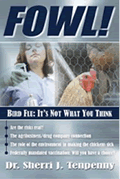FLU VACCINES AND THE RISK OF CANCER
Dr. Sherri Tenpenny, DO
September 4, 2009
NewsWithViews.com
Much
concern has been generated over the upcoming new swine flu H1N1 vaccines
that are being rushed to market. Clinical trials will be short –
less than three weeks – and the potential for the addition of toxic
oil-in-water adjuvants to be added at the last minute to stretch the vaccine
supply is disconcerting. However, the problems with flu shots go beyond
current concerns. The new manufacturing process for flu shots, called
cell-line technologies, are little understood and have the potential for
serious, long term consequences.
Manufacturing the “regular,” annual flu shot
Each year, between January and March, an FDA advisory panel selects the three influenza strains expected to be in circulation during the upcoming flu season. Admitting that the process is an “educated guess,” the CDC sends the selected seed virus to the FDA for approval prior. Seed virus is then distributed to manufacturers for production.
The annual flu shot contains three viral strains: two type influenza A viruses and one type influenza B. Most commonly, two of the viruses are the same viruses included in the preceding year’s shot. The third virus is typically a new strain in circulation. This is the purported reason for giving the shot each year. The new strain is modified through a laboratory process called reassortment to ensure that it can readily grow in eggs. Once the modification is complete, all three viruses proceed through tricky manufacturing steps to create what goes in that vial.
The cumbersome flu shot production process utilizes up to 500,000 fertilized chicken eggs per day for up to eight months. Hundreds of millions of fertilized eggs become “mini-incubators” for cultured viruses. When the chick embryos are 11-days old, the amniotic membrane (the egg white) is manually injected with a drop of viral-containing solution. Several days later, the gooey viral suspension is centrifuged to remove as much chicken blood and tissue from the solution as possible. Residual egg protein remains within the final vaccine solution and is the reason why persons with an egg allergy are advised against receiving the flu shot.
The entire process, from viral selection to viral harvest, can take up to nine months.[1] With the potential for a pandemic and the Director General of the WHO, Margaret Chan, requesting up to 4.9 billion of flu shots to vaccinate the world,[2] the slow lead time and labor-intensive production process cannot meet the demand for massive quantities of pandemic flu vaccine.
Enter Cell Line Technology
Cell line technologies, the use of cells and tissues for growing viruses found in vaccines, have been used since the 1950s. Examples include calf lymph for smallpox vaccines; African green monkey cells (AGMK cells) for polio vaccines and mouse brain cells for the Japanese encephalitis vaccine. In the 1960s, cells from aborted human fetal tissue, called MRC-5 and WI-38 cells, were developed and are still used for the manufacture of rubella chickenpox, hepatitis A and shingles vaccines.
Since the early 2000s, dozens of human and animal tissues have been investigated for use in viral vaccines, especially for the production of influenza shots. Batches of vaccine can be produced in less than six weeks instead of just one crop per year with eggs, a particularly useful methodology for ramping up production of flu shots.While many of the new cell lines are still considered experimental, cell line techniques have attracted all the major players in the vaccine and biotech industry.
Prior to 2007, cell lines were little used for flu shots, primarily for logistical reasons: Flu shots made from cells instead of eggs required a complete retooling of existing production facilities. None of the manufacturers were willing to invest the hundreds of millions of dollars and the five to seven years to construct new vaccine plants. But when the threat of the bird flu pandemic was hyped in 2006, the government opened is coffers and spilled billions of dollars into the pockets of the drug companies, giving them the capital to build new flu shot production facilities. By 2012, the first cell line factory will be completed in North Carolina. Vaccine giant, Novartis, will then have the capacity to produce 150 million flu shots per year, making it the number one commercial production plant for influenza vaccines and the adjuvant MF-59, in the world.
Cell Cultures: The Next Frontier in Vaccine Production
Several cell lines are currently under investigation. Novartis’ EU-approved flu shot, Optaflu, was produced using a cell line called Madin-Darby (MDCK), cells extracted from the kidneys of a female cocker spaniel. Dutch giant, Solvay Pharmaceuticals, has been working with MDCK cells since the early 1990s.
Another independent company, Protein Sciences Corporation, has been working on a patented influenza vaccine produced from caterpillar eggs. This vaccine strategy, known commercially as FluBlok, isolates a purified concentration of (H) antigen on the surface of an influenza virus and inserts the antigen into a second virus called a baculovirus. The (H)-containing baculovirus is then inserted into insect cells growing in culture. Several clinical trials involving the bug-created vaccine have shown that the antigens elicit a strong antibody response in humans.[3] The vaccine, no doubt, contains snips of insect DNA. This technology is being tested in Europe and is not yet approved for use in the US.
A third
type of cell line, called PER.C6 cells, is derived from retinal
cells of aborted fetal tissues. The fetal cells are transformed
by infecting them with an adenovirus, turning them into “immortalized”
cells and the capability to replicate endlessly. By their very nature,
these cells are neoplastic (cancer-causing); researchers refer to them
as “oncogenic” cells. If tumors are formed when the cells
are injected into experimental animals, the cell lines are beyond oncogenic;
they are tumorigenic.
A serious concern about whole, live PER.C6 cells is that they are capable
of causing tumors when transplanted into the skin of mice. The FDA requires
a filtration method to be used during vaccine production that is designed
to removes all cells before the final product is packaged. Even though
several studies have been conducted to assure vaccine developers that
PER.C6 cells do not cause cancer and do not contain stray tumor causing
viruses,[4]
the risk of the cells making their way into the final vaccine products
remain.
The risks of residual retinal DNA and stray viral contaminants from the animal tissues getting into flu shots are real. DNA snips are classified as either “infectious” or “oncogenic” by researchers who worry that the stray DNA is being incorporated into the recipient’s DNA, even thought FDA regulations insist on the “importance of minimizing the risk of oncogenesis in vaccine recipients.” Manufacturers have been instructed to ensure the final vaccine contains less than 1 million residual animal cells and the amount of stray DNA is less than 10 ng. per vaccine.[5] These regulations admit that animal DNA is injected into human babies and adults with every shot.
[NWV Poll: According to Fox News, 50% of US health care workers will refuse H1N1 vaccine. What will you do?]
Is every lot tested for purity and these parameters? No. Spot-checked lots are sent to the FDA and the FDA trusts the word of vaccine manufacturers that these standards have been met.
Tumorigenic Cells: The Risks Are Known
Since 1998, the FDA and its subdivision, the Centers for Biological Evaluation and Research (CBER), have been drafting regulations to allow use of both oncogenic and tumorigenic cell lines to be used in vaccine production. The FDA is fully aware that the new cell lines, especially the PER.C6 cells, have substantial risks, including the risk of potentially deadly adventitious [stray, outside] viruses making their way into shots. For example, the FDA acknowledges that the SV 40 virus (simian virus 40 from monkey kidney cells) was in the early polio vaccines and acknowledges the risks:
“The experience in the early 1960s with SV40 contamination of poliovirus and adenovirus vaccines and the continuing questions regarding whether SV40 could be responsible for some human neoplasms [cancers] underscores the importance of keeping viral vaccines free of adventitious agents [viral contaminants].
This is particularly important when there is a theoretical potential for contamination of a vaccine with viruses that might be associated with neoplasia [cancer]…It is unclear whether cell substrates have a greater or lower risk [of contamination] than other types of cells…However, if their growth in tissue culture is not well controlled, there may be additional opportunities for contamination…”[6]
And it gets worse.
The same FDA memo goes on to say:
“In addition to the possibility of contamination of cell substrates with adventitious viruses…the use of immortalized, neoplastic human cells to develop [vaccines] raises theoretical concerns with regard to possible contamination with TSE/BSE agents.”[7]
TSE is Transmissible Spongiform Encephalopathy, a condition that includes a group of rare degenerative brain disorders characterized by tiny holes in the brain tissues, giving a “spongy” appearance when viewed under a microscope. When this condition occurs in cows, it is called Bovine Spongiform Encephalopathy, commonly known as “mad cow disease.” In a study published in 2004, researchers found that any cell line could potentially support the propagation of TSE agents.[8]
Clearly, CBER is aware and disquieted over the carcinogenic potential of animal cells in vaccines because they require manufacturers to take “every available precautionary step” to eliminate the suspicious cells from the vaccine final product. The FDA also admits concerns about cancer-causing possibility from all types of cell lines. The question begging to be answered is, knowing the potential risks of using cell lines to create vaccines, why is research using cell line technologies allowed to be used at all?
|
Subscribe to the NewsWithViews Daily News Alerts! |
Despite substantial evidence—and even admissions of concern—the FDA appears to be flagrantly ignoring the potential for harm caused by this new cell line technology. The U.S. government have poured billions of dollars into flu shot development and is recklessly approving the use of cell lines for products that have a questionable necessary pandemic vaccine. Let the buyer beware.
Footnotes:
1,
“WHO manual on animal influenza diagnosis and surveillance,”
World Health Organization,
1 September 2004.
2,
Reuters
May 19, 2009.
3,
“Influenza
Vaccines under development,” Protein Sciences Corporation.
4,
Ledwith, BJ, et al. “Tumorigenicity assessments of Per.C6 cells
and of an Ad5-vectored HIV-1 vaccine produced on this continuous cell
line.” Dev Biol (Basel). 2006;123:251-63; discussion 265-6.
5,
FDA: Use
of MDCK Cells for Manufacture of Inactivated Influenza vaccines.
6,
"Designer
Cells as Substrates for the Manufacture of Viral Vaccines,”
FDA.
7,
FDA. Ibid MDCK cells
8,
Vorberg, I., Raines, A., Story, B., Priola, S. A. “Susceptibility
of common fibroblast cell lines to transmissible spongiform encephalopathy
agents,” Journal of Infectious Diseases189 (2004): 431–439.
PMID: 14745700.
� 2009 - Sherri Tenpenny - All Rights Reserve
Sign
Up For Free E-Mail Alerts
E-Mails are used strictly for NWVs
alerts, not for sale
Sherri J. Tenpenny, D.O., is regarded as one of the country’s most knowledgeable and outspoken physicians on the negative impact vaccines can have on health. This article includes excerpts from her new book, Saying No to Vaccines: A Resource Guide for All Ages. In addition to concerns about childhood vaccinations, the book addresses vaccination issues facing adults, international travelers, healthcare workers, nursing home residents, adoptions, college students, and those in the military. A 75-minute DVD is included that discusses the history of mandatory vaccination, concerns about the HPV cervical cancer vaccine Gardasil and other information not included in the book. For more information on her many other books, DVDs, audio CDs, articles, and other materials, visit DrTenpenny.com and SayingNoToVaccines.com Learn more about her medical clinic at osteomed2.com.
Dr. Tenpenny is a regular columnist for NewsWithViews.com. Her new book and DVD "Saying No to Vaccines" and FOWL! are available through this site. Other tapes and materials are available www.DrTenpenny.com
Website: www.DrTenpenny.com
Website: www.SayingNoToVaccines.com
E-Mail: nmaseminars@aol.com















